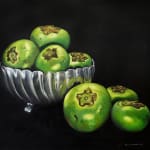
 Installation images by Daniel Terna
Installation images by Daniel Terna
 Installation images by Daniel Terna
Installation images by Daniel Terna
Pedro Diego Alvarado-Rivera Mexican, b. 1956
Reflejos de Zapotes, 2024
Oil on linen
40.16 x 43.75 in
102 x 118 cm
102 x 118 cm
Further images
Featuring tropical fruit native to Mexico and Central America, Alvarado highlights the Zapote. A green-skinned fruit with black flesh, its name comes from the Nahuatl word tzapotl, meaning a soft,...
Featuring tropical fruit native to Mexico and Central America, Alvarado highlights the Zapote. A green-skinned fruit with black flesh, its name comes from the Nahuatl word tzapotl, meaning a soft, sweet fruit. Alvarado presents them elegantly, placing them on and around a fine silver bowl. The rich, dark background makes the food the focal point of the piece, emphasizing the uniqueness of each item. The artist views his work as a celebration of Mexico’s native flora and fauna, cementing the Zapote’s role in history as a fruit that symbolizes reverence for Mesoamerican foods and their significance in indigenous and national culture.
"Pedro Diego Alvarado-Rivera’s 'Reflejos de Zapotes” is the most
straightforward interpretation of a classic bodegón. Nearly photorealistic, it is
an unabashedly proud vision of Mr. Alvarado-Rivera’s native Mexico. The painter
(the grandson of the famed muralist Diego Rivera) shows fruit common to the
region but little known outside of it spilling from a gleaming silver bowl, putting
the natural riches of his homeland on equal footing with the more readily
recognized value of precious metals." Brian P. Kelly, The Wall Street Journal, Aug. 2, 2024
"Pedro Diego Alvarado-Rivera’s 'Reflejos de Zapotes” is the most
straightforward interpretation of a classic bodegón. Nearly photorealistic, it is
an unabashedly proud vision of Mr. Alvarado-Rivera’s native Mexico. The painter
(the grandson of the famed muralist Diego Rivera) shows fruit common to the
region but little known outside of it spilling from a gleaming silver bowl, putting
the natural riches of his homeland on equal footing with the more readily
recognized value of precious metals." Brian P. Kelly, The Wall Street Journal, Aug. 2, 2024



